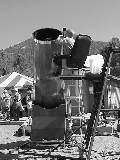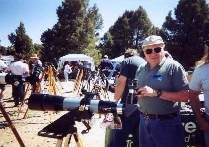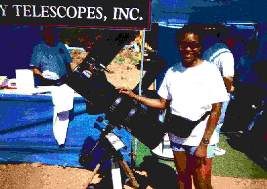How I Bought My First Telescope
Posted On January 1, 2000
By Christine K. McGill, Sirius Astronomer Editor
If you don't currently own a telescope, you might want to wait before you decide to buy. You might not, however, want to wait as long as I did after joining the OCA: 2 years and 9 months.
Well, I didn't want to rush into a decision. I was busy. I didn't want to make the wrong choice and commit to something I might eventually come to dislike. Cost was another factor. And, finally, there was the fact that I could always borrow one. The club has some fine telescopes for members to borrow, such as the first one I used, a 10-inch Coulter Dobsonian. So, I took matters slowly: I learned my way around the sky with my binoculars and the Dobsonian. I also learned how to use the 10-inch Meade LX-200 SCT at the Anza Observatory, with it's object library and GOTO capabilities. Nice.
But, I have neither a "GOTO" nor an "ATM" personality. I could neither persuade myself to invest in an instrument that would do all the thinking for me, nor did I want to make one. Rock bottom, I just wanted a traditional telescope.

What to buy? Well, I thank my lucky stars that I didn't run out to buy a grocery-store telescope! (I actually saw a posting to the sci.astro.amateur newsgroup that read: "What are the best brands? Who sells absolutely the cheapest? I was looking at a telescope at Wal-Mart recently") I believe that the best way to check out telescopes is to borrow one from the club or a friend, to go to star parties and spend some time with other club members, who are very willing to answer any questions one might have, to get involved with the use and maintenance of the club's telescopes. In addition, one should read everything one can find in print or on the internet. There is an excellent website called "The Telescope FAQ" (url: http://www.qnet.com/~starlord/TELSCOPE.FAQ), which is only one of many. Sky and Telescope's pamphlet "Choosing Your First Telescope" is available from the club and from their website. In addition, many OEMs and resellers provide general information on telescopes for the potential buyer.
As it turns out, I was looking at ads on the internet and in magazines for about 2 weeks prior to my attending RTMC. I must have made a subconscious decision, because once I arrived at Big Bear, I had to buy a telescope. I could think of nothing else. This was only my second RTMC; at my first one, my big purchase was a set of books by Brent Watson, the "Finder Charts of the Messier Objects", designed for Telrad users. Thinking about my pocketbook, I was led (or misled) first to the used telescope vendors. I almost bought a 4-inch Meade refractor, when Don Lynn showed up and talked me out of it. I walked over to the Meade booth and stopped by Al Nagler is booth as well. Nothing really excited me, though. Later, in the women is dorm, I spoke to someone whose boyfriend sells scopes, and I went and looked at it and walked away (quickly) because it was dinnertime. At dinner, I expressed my desire to buy a telescope contingent upon my failing to win one at the door prize drawing. I enlisted Don Lynn and John Sanford and felt confident that I could arrive at the right decision with the two of them along.
The following morning, we took off after breakfast, and arrived at a vendor of telescope-making kits. Uh-uh. The next booth belonged to Discovery Telescopes. I had never heard of them, but we stopped to look. The company is located in Oceanside, and they are a supplier of mirrors and telescopes to several big-name telescope companies. I grew increasingly interested, because the price range for their Newtonian reflectors was just right for me. (The company sells direct to the public.) Moreover, the telescopes on display (several Newtonian reflectors and a Dobsonian) were attractive, with a glossy black finish and mounted on aluminum tripods. There were 4.25-, 6- and 8-inch Newtonians on display. I was drawn to the 6-inch f/5 for its cost ($499), and asked John and Don to look at it.

The glass parabolic primary mirror showed crisp images, but I'm not an expert. My friends were impressed with the optics, and the mount appeared stable enough. Then, John reminded me of something Doug Millar had mentioned at breakfast: "Don't buy anything less than an 8-inch!" He pointed out that the 8-inch f/5 also included a DC motor drive (the RTMC special) for free, and the extra 2 inches of aperture would make a great difference. Aperture rules, right? Right! I made a deal for the telescope, which comes with a 25-mm Plossl, 2- and 1.25-inch rack-and-pinion focuser, mount and tripod (same as Orion's SkyView Deluxe EQ), the free DC drive and a 10-mm Plossl for less than $600, and I still haven't stopped smiling!

My telescope (named Lucille) is beautiful and very portable. I can setup and break down in under 20 minutes. I've hauled it to the Silverado star party, the Anza star party, to the Discovery museum in Santa Ana, and to Jim Benet's house. I've viewed the Dumbbell nebula, Albireo in Cygnus, Mizar in Ursa Major and M13, just to name a few objects. They are truly stunning and clear right out to the edge of the field. I'm never disappointed by the images, and no wonder: Discovery boasts these mirrors are accurate to 1/10 wave. Aaron Imaoka tried out his TeleVue zoom eyepiece (8 to 24 mm) on my scope, and now, I am really hooked. That must be what happens: you buy the scope, then you just spend, spend, spend to enhance it even more. Eventually, I want to try my hand at piggyback photography, but right now, I'm just content to learn my way round the sky, just like I wanted.
Check out Discovery Telescope's website at: http://www.discovery-telescopes.com, or call them at: 760-967-6598. The company's founders, Terry Ostahowski and Bill Larsen, are friendly and patient, and they also provide excellent technical support.